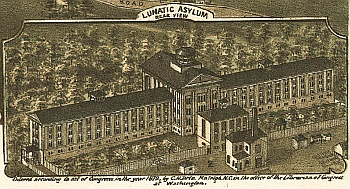Dorothea Dix Hospital
by Harry McKown UNC - North Carolina Collection, 2006; Revised by NC Government & Heritage Library, June 2022; Revised by SLNC Government and Heritage Library, June 2023
Sourced from "This Month in North Carolina History" series. Reprinted with permission.
 In the 1830s and 1840s the United States was swept by what one historian has described as a ferment of humanitarian reform. Temperance, penal reform, women's rights, and the antislavery movement, among others, sought to focus public attention on social problems and agitated for improvement. Important among these reform movements was the promotion of a new way of thinking about and treating mental illness. Traditionally, people with mental illnesses could not be kept with their families became the responsibility of local government, and were often kept in common jails or poorhouses where they received no special care or medical treatment. Reformers sought to create places of refuge for people with mental illnesses where they could be cared for and treated. By the late 1840s, all but two of the original thirteen states had created hospitals for people with mental illnesses, or had made provision to care for them in existing state hospitals. Only North Carolina and Delaware had done nothing.
In the 1830s and 1840s the United States was swept by what one historian has described as a ferment of humanitarian reform. Temperance, penal reform, women's rights, and the antislavery movement, among others, sought to focus public attention on social problems and agitated for improvement. Important among these reform movements was the promotion of a new way of thinking about and treating mental illness. Traditionally, people with mental illnesses could not be kept with their families became the responsibility of local government, and were often kept in common jails or poorhouses where they received no special care or medical treatment. Reformers sought to create places of refuge for people with mental illnesses where they could be cared for and treated. By the late 1840s, all but two of the original thirteen states had created hospitals for people with mental illnesses, or had made provision to care for them in existing state hospitals. Only North Carolina and Delaware had done nothing.
Interest in the treatment of mental illness had been expressed in North Carolina in 1825 and 1838 but with no results. Several governors suggested care of people with mental illnesses to the General Assembly as a legislative priority, but no bill was passed. Then in the autumn of 1848 the champion of the cause of treatment of people with mental illness made North Carolina the focus of her efforts. Dorothea Lynde Dix was a New Englander born in 1802. Shocked by what she saw of the treatment of women with mental illnesses in Boston in 1841 she became a determined campaigner for reform and was instrumental in improving care for people with mental illnesses in state after state.
 In North Carolina Dix followed her established pattern of gathering information about local conditions which she then incorporated into a "memorial" for the General Assembly. Warned that the Assembly, almost equally divided between Democrats and Whigs, would shy from any legislation which involved spending substantial amounts of money, Dix nevertheless won the support of several important Democrats led by Representative John W. Ellis who presented her memorial to the Assembly and maneuvered it through a select committee to the floor of the House of Commons. There, however, in spite of appeals to state pride and humanitarian feeling, the bill failed. Dix had been staying in the Mansion House Hotel in Raleigh during the legislative debate. There she went to the aid of a fellow guest, Mrs. James Dobbins, and nursed her through her final illness. Mrs. Dobbins's husband was a leading Democrat in the House of Commons, and her dying request of him was to support Dix's bill. James Dobbins returned to the House and made an impassioned speech calling for the reconsideration of the bill. The legislation passed the reconsideration vote and on the 29th day of January, 1849, passed its third and final reading and became law.
In North Carolina Dix followed her established pattern of gathering information about local conditions which she then incorporated into a "memorial" for the General Assembly. Warned that the Assembly, almost equally divided between Democrats and Whigs, would shy from any legislation which involved spending substantial amounts of money, Dix nevertheless won the support of several important Democrats led by Representative John W. Ellis who presented her memorial to the Assembly and maneuvered it through a select committee to the floor of the House of Commons. There, however, in spite of appeals to state pride and humanitarian feeling, the bill failed. Dix had been staying in the Mansion House Hotel in Raleigh during the legislative debate. There she went to the aid of a fellow guest, Mrs. James Dobbins, and nursed her through her final illness. Mrs. Dobbins's husband was a leading Democrat in the House of Commons, and her dying request of him was to support Dix's bill. James Dobbins returned to the House and made an impassioned speech calling for the reconsideration of the bill. The legislation passed the reconsideration vote and on the 29th day of January, 1849, passed its third and final reading and became law.
Architect Alexander Jackson Davis designed the hospital's main building to accommodate 274 patients. For the next seven years, construction of the new hospital advanced slowly on a hill overlooking Raleigh. The hospital opened in 1856 as the North Carolina Hospital for the Mentally Ill.
Although the hospital would ultimately be named after Dorothea Dix, she refused to allow the hospital to be named after herself during her lifetime. She permitted the site on which it was built to be called Dix Hill in honor of her father. In 1959, the General Assembly voted to change the institution's name to Dorothea Dix Hospital.
Due primarily to lack of funding, the process of closing Dorthea Dix Hospital began in 2000. Various parcels of land on the campus were transferred to other purposes. Efforts and discussions to close the hospital increased from 2008 to 2010. In 2010, it was announced that the facility would close its doors. In 2012, the last patients were relocated to Central Regional Hospital in Butner. In 2015, the state approved sale of 300-plus acres to the city of Raleigh for the development of Dorthea Dix Park.
At the closing of Dorthea Dix Hospital, historical and medical records from the institution were transferred to the State Archives of North Carolina and the Central Regional Hospital in Butner. Historical documents and records are in the collection of the Archives, while more contemporary medical records can be obtained from the Central Regional Hospital.
References and additional resources
Margaret Callendar McCulloch, "Founding the North Carolina Hospital for the Insane," North Carolina Historical Review, vol.13:3 (July, 1936).
Dorothea Lynde Dix, Memorial soliciting a state hospital for the protection and cure of the insane: submitted to the General Assembly of North Carolina, November, 1848. Raleigh, N.C.: Seaton Gales, printer for the State, 1848.
Dorothy Clarke Wilson, Stranger and traveler: the story of Dorothea Dix, American reformer. Boston: Little Brown, 1975.
Richard A. Faust, The story of Dorothea Dix Hospital. Raleigh, N.C., 1977.
Image Credits
Drie, C. N. "Bird's eye view of the city of Raleigh, North Carolina 1872." Digital ID g3904r pm006660. Library of Congress Geography and Map Division Washington, D.C. 20540-4650 USA. http://hdl.loc.gov/loc.gmd/g3904r.pm006660.
"Dorothea Dix." Photograph no. N53-15-1493. From the North Carolina State Archives, Raleigh, NC.
1 January 2006 | McKown, Harry W., Jr.